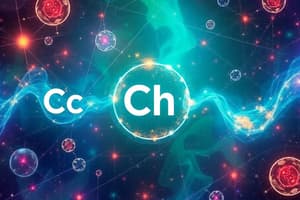Podcast
Questions and Answers
What defines the identity of an element?
What defines the identity of an element?
- The number of neutrons in its atoms
- The number of protons in its atoms (correct)
- The number of electrons in its atoms
- The overall mass of its atoms
Which of the following examples represents a substance?
Which of the following examples represents a substance?
- Salt (sodium chloride) (correct)
- Air
- Smoke
- Dust
What is a molecule?
What is a molecule?
- An atom that has lost an electron
- An element in its purest form
- A single atom
- Two or more atoms held together by a chemical bond (correct)
Who created the first version of the periodic table?
Who created the first version of the periodic table?
What is the definition of matter?
What is the definition of matter?
Which property distinguishes different elements from one another?
Which property distinguishes different elements from one another?
What happens when elements combine?
What happens when elements combine?
What are atoms primarily composed of?
What are atoms primarily composed of?
Which of the following states of matter does not have a fixed shape?
Which of the following states of matter does not have a fixed shape?
Which of the following pairs of atoms combine to form water?
Which of the following pairs of atoms combine to form water?
In the context of chemistry, how can chemical changes be illustrated?
In the context of chemistry, how can chemical changes be illustrated?
What aspect of the periodic table helps organize elements?
What aspect of the periodic table helps organize elements?
What is the primary role of protons and neutrons in an atom?
What is the primary role of protons and neutrons in an atom?
Which description accurately portrays the motion of atoms?
Which description accurately portrays the motion of atoms?
What analogy is used to describe atoms in the text?
What analogy is used to describe atoms in the text?
How do gases differ from solids and liquids in terms of their properties?
How do gases differ from solids and liquids in terms of their properties?
Flashcards are hidden until you start studying
Study Notes
Introduction to Chemistry
- Chemistry explores the properties of matter, including how substances change, combine, and interact.
- Real-world examples, such as baking cookies, illustrate chemical processes.
What is Matter?
- Matter is anything that has mass and occupies space, including air, water, and various materials.
- Exists in three states: solids (e.g., ice), liquids (e.g., water), and gases (e.g., air).
Atoms: Nature's Building Block
- Atoms are the smallest units of matter, compared to tiny LEGO bricks.
- Cannot be seen with the naked eye but form the basis of all substances.
- Each atom consists of three subatomic particles: protons, neutrons, and electrons.
- Protons and neutrons form the nucleus, while electrons orbit around it.
- The number of protons in an atom defines the element (e.g., one proton for hydrogen, six for carbon).
Elements: Nature's Alphabet
- An element is a pure substance that cannot be chemically or physically broken down.
- Each substance has a specific composition; for example, water is always H₂O.
- Elements serve as the simplest forms of matter, made up of unique types of atoms.
- The periodic table organizes elements by their properties and includes their symbols (e.g., H for hydrogen, O for oxygen).
- Dmitri Mendeleev created the first periodic table, which is continuously updated with new discoveries.
Molecules: Mixing and Combining Elements
- Molecules form when two or more atoms combine through chemical bonds, creating new substances with distinct properties.
- Example: Two hydrogen atoms and one oxygen atom create water (H₂O), essential for life.
- Molecules can vary in complexity, from simple ones like oxygen to more intricate structures like sugars.
Chemistry in Everyday Life
- Chemistry is integral to daily activities, affecting everything from cooking to environmental interactions.
Studying That Suits You
Use AI to generate personalized quizzes and flashcards to suit your learning preferences.




